 W
WBarequeçaba is a beach located 7 km south from the centre of the Brazilian city of São Sebastião, São Paulo, following the BR-101 highway which is the main road going along the Brazilian coast from Rio de Janeiro to Santos.
 W
WBoa Viagem is a neighborhood in the city of Recife, Pernambuco in the privileged southern zone of the town. The neighborhood has one of the most visited beaches in Northeastern Brazil, Boa Viagem beach.
 W
WBoiçucanga is a beach and neighborhood in the city of São Sebastião, located on São Paulo state's northern coastline. The name comes from the Tupiniquim Indian language. Boi means snake. Açu means big and Canga means head. The sea at the beach is calm and has thick, yellowish sand.
 W
WCanoa Quebrada, known as the pearl of the east coast of Ceará, Brazil, is an international tourist beach resort 164 km from Fortaleza, in the municipality of Aracati.
 W
WGenipabu is a beach with a complex of dunes, a lagoon and an environmental protection area (APA) located close to Natal, one of the most famous post-cards of the Rio Grande do Norte Brazilian state.
 W
WItacoatiara is one of the 48 official neighborhoods into which the city of Niterói, Rio de Janeiro in Brazil is divided.
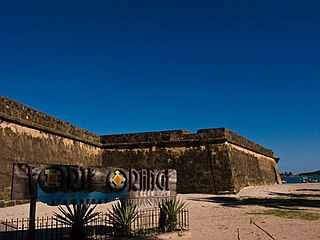 W
WIlha de Itamaracá is a tropical island and municipality in Pernambuco, Brazil on the Atlantic Ocean. Itamaracá means "stone shaker" in Tupi, from the words itá ("stone") and mbara'ká ("shaker"). It is separated from the mainland by the Canal de Santa Cruz, a salt water channel both mouths of which are on the Atlantic Ocean, and is connected to the mainland by a long road bridge.
 W
WItapirubá is located in Imbituba, state of Santa Catarina, Brazil, sharing borders with Laguna. It is close to historical cities like Laguna, Imbituba and other sights. Itapirubá has beautiful beaches, dunes and a lake. There are two beaches separated by a hill; from the hill a headland and the island Ilha das Araras can be seen. The clear waters around the Ilha are a popular fishing and diving location.
 W
WJericoacoara is a virgin beach hidden behind the dunes of the west coast of Jijoca de Jericoacoara, Ceará, Brazil. Selected by The Washington Post as one of the Top 10 most beautiful beaches in the world, "Jeri" consists of blue lagoons, calm seas and huge dunes.
 W
WMangue Seco is a beach village in Jandaíra, Bahia, Brazil. It is very famous in Brazil because of a soap-opera (telenovela) adaptation of the novel Tieta do Agreste, by the Brazilian writer Jorge Amado, which was shot on its white beaches in 1996.
 W
WMaracajaú (Tupi) is a community and beach located in the Brazilian city of Maxaranguape, state of Rio Grande do Norte. With a population of approximately 2,000 people the main source of income is fishing followed by tourism.
 W
WMaresias is a beach and district at the Atlantic Ocean in the city of São Sebastião, located on São Paulo state's northern coastline, Brazil. The name comes from the ocean breeze that affects the beach and the neighborhood.
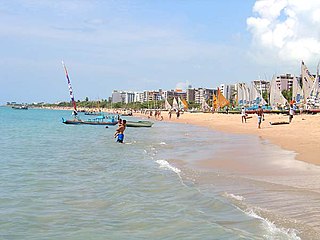 W
WPajuçara is a beach and a neighborhood in Maceió, capital of Alagoas, in Brazil. The Estádio Severiano Gomes Filho is located in the neighborhood. This beach is approximately 2 km from downtown. It is a calm water beach thanks to the reefs, which make it safe for swimming, especially for children. Near the arts and crafts fair in Pajuçara is also where the rafts leave for the natural pools formed by choral reefs, where the tourist will find floating bars.
 W
WPipa Beach is one of the most famous beaches of Brazil. Located next to city of Natal, the capital city of state of Rio Grande do Norte. Is located more precisely in municipality of Tibau do Sul, exactly 84 km from the capital of the state.
 W
WPonta Negra is a beach and neighborhood located in the Brazilian city of Natal, the capital of the state of Rio Grande do Norte. Located in the extreme south of the beach is the Morro do Careca, a large dune and a landmark of the city. Located in the extreme north of the beach is the Via Costeira, a coastal road that connects Ponta Negra with several other beaches of the city, such as Areia Preta and Praia dos Artistas.
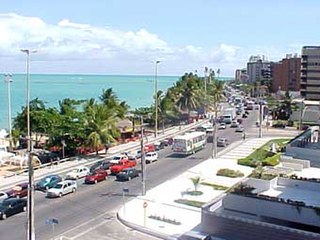 W
WPonta Verde is a beach in Maceió, capital city of Alagoas, state of Brazil. A tip of land that rises out of the sea and is covered by green palm trees. This is the phenomenon that gave its name to one of the most frequented beaches in Maceió. In the past, it housed one of the most famous symbols of the city, “The Rhea Neck”, a palm tree whose trunk resembled a rhea’s neck. It was located near the present Yacht Club Alagoas. The reefs form natural pools and it is very common, during low tides, to see tourists bathing in these pools, especially near the lighthouse. There are some stands with live music, bars, restaurants, snack bars, and hotels.
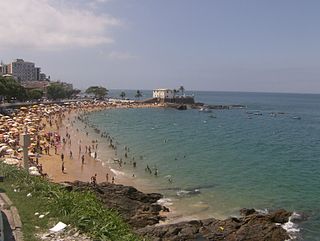 W
WPorto da Barra Beach is located in Barra neighborhood in the city of Salvador, Brazil. It is located at the entrance of the Baía de Todos os Santos, with a small, white colonial fort at one end and a whitewashed church sitting up on a hill at the other.
 W
WPorto de Galinhas is a beach in the municipality of Ipojuca, Pernambuco, Brazil. Porto de Galinhas is a major tourist destination. The beach is famous for its bright-water beaches and the natural pools. It is part of the municipality of Ipojuca, and located 60 kilometers (37 mi) south of the state capital, Recife. The municipality of Ipojuca, where Porto de Galinhas lies, was established on November 12, 1895.
 W
WPraia de Iracema is a beach and a neighborhood located in the Brazilian city of Fortaleza in the state of Ceara. Its name comes from the character Iracema that gives name to a famous novel by the cearense writer José de Alencar.
 W
WPraia do Cassino is the southernmost beach of the Brazilian coast, on the South Atlantic Ocean, in the state of Rio Grande do Sul. It is thought to be the longest uninterrupted sandy seashore in the world, with various sources measuring it from 212 kilometres (132 mi) to 254 kilometres (158 mi), stretching from the Molhes (breakwaters) at the entrance of the Rio Grande seaport in the north to the mouth of the Chuí Stream, on the border with Uruguay, in the south.
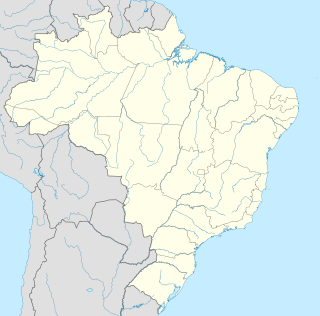 W
WPraia do Forte is a long beach with a small village 80 km away from the city of Salvador de Bahia, located in northeastern Brazil and facing the Atlantic Ocean. The beach is known for its clear waters, white sand, natural pools, rivers and an ecological reserve of native flora and fauna.
 W
WPraia do Gunga is located 20 miles south of Maceió, Alagoas. It is considered to be one of the most beautiful beaches in Brazil.
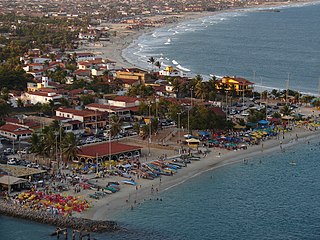 W
WRedinha beach is a beach located on the Brazilian capital city Natal, Rio Grande do Norte.
 W
WTamandaré is a coastal municipality about 103 km (64 mi) south of Recife, the capital city of the Brazilian state of Pernambuco.
 W
WTambaba is an official nudist beach in Brazil, located on the Atlantic coast 20 km (12 mi) south of João Pessoa and 115 km (71 mi) north of Recife, at 7°21′57″S 34°47′50″W. In Tambaba, one must be nude in the family area. Around the periphery of the beach, nudism is optional.
 W
WToque-Toque Grande and Toque-Toque Pequeno are two beaches at the Atlantic Ocean in the city of São Sebastião, SP, Brasil. They are separated by another beach called "das Calhetas", being 2,4km away from each other.